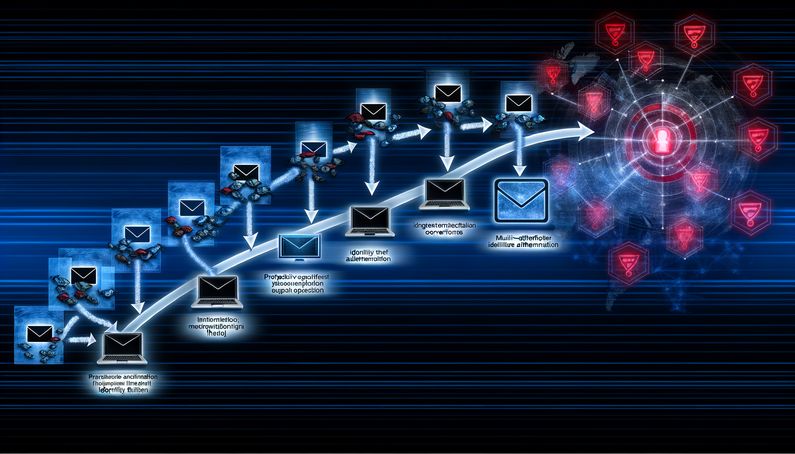
The Evolution of Phishing Attacks: From Links to Identity Theft
Phishing attacks have transformed from simple email scams into complex identity theft operations, challenging even the most robust security measures. As attackers shift from traditional methods to identity-based techniques, they exploit vulnerabilities in multi-factor authentication (MFA) systems, using sophisticated phishing kits that bypass SMS, OTP, and push-based protections. This evolution has rendered many traditional detection methods obsolete, as attackers now employ dynamic phishing pages that adapt in real-time, making them difficult to detect and block. These pages utilize JavaScript to dynamically alter content, and attackers rotate URLs to evade tracking, presenting a formidable challenge to cybersecurity teams (BleepingComputer).
The Evolution of Phishing Attacks: From Links to Identity Theft
The Shift from Traditional Phishing to Identity-Based Techniques
Over the past few years, phishing attacks have evolved significantly, moving from simple email-based scams to sophisticated identity theft operations. Traditionally, phishing attacks relied on deceiving users into clicking malicious links that led to fraudulent websites designed to steal login credentials. However, as security measures have improved, attackers have shifted their focus to identity-based techniques, which pose a greater threat to users and organizations alike.
Attackers are increasingly leveraging identity-based techniques over software exploits, making phishing a more formidable threat. These techniques often involve the use of MFA-bypassing phishing kits that can compromise accounts protected by SMS, OTP, and push-based methods. This shift in tactics has put immense pressure on detection controls, as traditional prevention methods are no longer sufficient to thwart these advanced attacks.
The Role of Dynamic Phishing Pages
One of the key developments in the evolution of phishing attacks is the use of dynamic phishing pages. Unlike static HTML pages, modern phishing sites are dynamic web applications rendered in the browser. These pages use JavaScript to dynamically rewrite content and launch malicious activities, making it difficult for traditional security measures to detect them.
Attackers have also implemented techniques such as dynamic rotation of links, where each visitor is served a different URL from a continually refreshed pool. This makes it challenging for security teams to track and block these malicious sites, as the URLs change frequently. Additionally, attackers use one-time magic links, which prevent security personnel from investigating the page after the initial interaction.
Bypassing Traditional Detection Methods
To evade detection, attackers have developed methods to bypass traditional security measures, such as email and network-based solutions. These solutions rely on inspecting and analyzing pages to identify malicious content. However, attackers have implemented bot protection mechanisms, such as CAPTCHAs and Cloudflare Turnstile, to prevent automated analysis of their pages.
By requiring user interaction, these bot checks effectively bypass sandbox analysis tools used by security solutions. As a result, attackers can ensure that their phishing pages remain undetected until a victim interacts with them. This highlights the need for more advanced detection methods that can observe and analyze pages in real-time, as users see them.
The Importance of Real-Time Browser-Based Detection
Given the limitations of traditional detection methods, there is a growing need for real-time browser-based detection solutions. These solutions can observe and analyze web pages as they are rendered in the user’s browser, providing a more accurate assessment of potential threats. By focusing on the browser, which has become the new operating system for modern work, security solutions can gain the visibility needed to detect and stop phishing attacks in real-time.
Real-time browser-based detection can identify suspicious activities, such as the presence of login forms and the entry of credentials, allowing security teams to intervene before attackers can steal sensitive information. This approach moves beyond the current cat-and-mouse game, where attackers are always two steps ahead, and provides a more proactive defense against phishing attacks.
The Future of Phishing Detection and Prevention
As phishing attacks continue to evolve, it is crucial for organizations to adopt more advanced detection and prevention strategies. This includes leveraging threat intelligence feeds and security products that can analyze and block phishing pages before they are used in attacks. Additionally, organizations should focus on protecting their identity attack surfaces by implementing solutions like Push Security, which prevent account takeover attacks such as MFA-bypass phishing, credential stuffing, password spraying, and session hijacking.
By adopting a comprehensive approach to phishing detection and prevention, organizations can better protect their users and data from the ever-evolving threat landscape. This requires a combination of real-time browser-based detection, advanced threat intelligence, and proactive identity protection measures to stay ahead of attackers and safeguard against identity theft.
Final Thoughts
The landscape of phishing attacks is rapidly evolving, necessitating a shift in how organizations approach detection and prevention. Traditional methods are no longer sufficient, as attackers continue to innovate with dynamic phishing pages and identity-based techniques. Real-time browser-based detection offers a promising solution, allowing security teams to analyze threats as they appear to users. By integrating advanced threat intelligence and focusing on identity protection, organizations can better safeguard against these sophisticated attacks. Embracing these strategies will be crucial in staying ahead of attackers and protecting sensitive information (BleepingComputer).
References
- Phishing detection is broken: Why most attacks feel like a zero day, 2024, BleepingComputer source url



